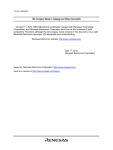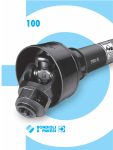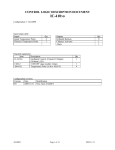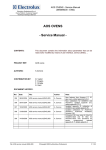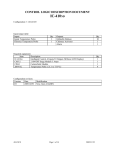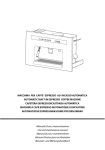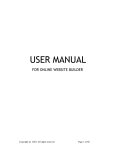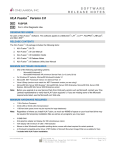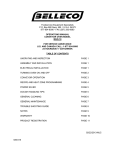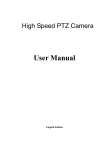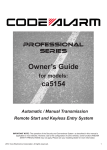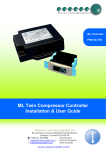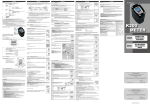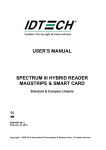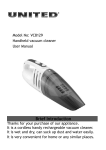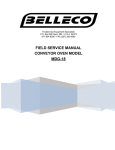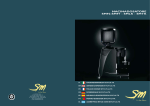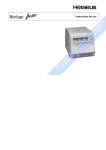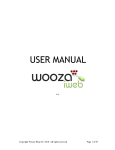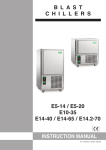Download BCE5009 Manual - International Catering Equipment
Transcript
ENGLISH Thank you for choosing this product. Please read the warnings contained in this manual carefully, as they provide important information regarding safe operation and maintenance. Make sure to keep this manual for any future reference by the various operators. In some parts of the manual, the be observed for safety purposes. symbol appears, indicating an important warning that must CHAPTER 1 BOUNDARY CHARACTERISTICS OF OPERATION The blast chiller has been designed and built to operate in optimal conditions at temperatures of up to +43°C, with adequate air circulation. In places with characteristics that are different from the requirements, the stated performance cannot be guaranteed. The supply voltage must be 230V +/- 10% 50Hz as standard, or as indicated on the EC label. The following table shows the cooling and/or freezing capacity in kg. Model Blast chilling +90°C / +3°C BASIC MINI BASIC ABF 03 BASIC ABF 05 E BASIC ABF 05 C Rapid freezing +90°C / -18°C 7 Kg. 10 Kg. 14 Kg. 20 Kg. 4 Kg. 5 Kg. 9 Kg. 12 Kg. N.B.: the times and quantities in kg above are valid for products with a maximum thickness of 4 cm. The blast chiller complies with the European directives as described in detail in the Annex “EC Declaration of Conformity” The data are reported on the EC label placed in the blast chiller, inside the engine compartment. Manufacturing Company Modello Model Code article Operating voltage Power consumption Type of coolant Cod.Art Code Model Matricola Ser. Number Tensione Tension Assorbimento Absorption Registration Number Climate class CL. A Gas Gaz Kw Electrical power Kg Quantity of coolant The manufacturer declines any liability for improper use of the blast chiller, as well as use that could not have been reasonably foreseen, and for all operations performed on it that disregard the instructions in the manual. 29 ENGLISH The main general safety standards are listed below: - do not use or place electrical devices inside the refrigerated compartments if they are not of the type recommended by the manufacturer - do not touch the blast chiller with damp or wet hands or feet - do not use the blast chiller barefoot - do not insert screwdrivers or other objects between the guards or moving parts - do not pull the power cord to unplug the blast chiller from the electricity network - the blast chiller is not intended to be used by persons (including children) with physical or mental problems, or lack of experience and knowledge, unless they are controlled or instructed in using the unit by a person responsible for their safety. Children must be supervised to ensure that they do not play with the appliance. - before carrying out any cleaning or maintenance, disconnect the blast chiller from the mains power supply by turning off the main switch and pulling the plug - in the event of failure and/or malfunction of the blast chiller, turn it off and to refrain from any attempt to repair or intervene directly. It is necessary to exclusively contact a qualified technician. The blast chiller is composed of a modular monocoque coated with different materials and insulated with polyurethane foam of density 42 kg/m3. In the design and construction, all measures have been adopted to ensure a blast chiller that complies with safety and hygiene requirements, such as: rounded interior corners, deep drawing with drain on the outside for the condensate liquids, no rough surfaces, fixed guards on moving or dangerous parts. The products must be stored in observance of the load limits given in the table, in order to ensure an efficient circulation of air inside the blast chiller. Load capacity BASIC MINI BASIC ABF 03 BASIC ABF 05 E BASIC ABF 05 C 3 x GN 2/3 3 x GN 1/1 5 x GN 1/1 5 x GN 1/1 - - 5 x EN 60x40 5 x EN 60x40 - - 6x 6x The installation must be performed exclusively by a qualified technician 1.1 It is prohibited to remove the guards and safety devices t is absolutely forbidden to remove safety guards. The manufacturer disclaims any liability for accidents due to failure to comply with this obligation. 1.2 Information on emergency operations in the event of fire - disconnect the blast chiller from the electrical outlet or cut off the main power supply - do not use water jets - use dry chemical or CO2 extinguishers 30 ENGLISH CHAPTER 2 CLEANING THE REFRIGERATOR Since the blast chiller will be used to store food, cleaning is necessary for hygiene and health protection purposes. The cleaning of the blast chiller has already been carried out at the factory. It is suggested, however, to carry out an additional cleaning of the internal parts before use, making sure that the power cord is unplugged. 2.1 Cleaning the interior and exterior cabinet For this purpose the following are indicated - the cleaning products: water and mild, non-abrasive detergents. DO NOT USE SOLVENTS AND THINNERS - methods for cleaning: wash the interior and exterior parts with warm water and mild soap or with a cloth or sponge with suitable products - disinfection: avoid substances that can alter the organoleptic characteristics of the food - rinsing: cloth or sponge soaked in warm water. DO NOT USE WATER JETS - frequency: weekly is recommended, the user can set different frequencies depending on the type of food being stored. REMARK : Clean frequently the door seals. Some preserved products could release some enzymes that could damage the seals causing its quick deterioration. For the cleaning, use only specific products for this purposes, available also on request on our sales network. 2.2 Cleaning the condenser The efficiency of the blast chiller is compromised by the clogging of the condenser, therefore it is necessary to clean it on a monthly basis. Before carrying out this operation, switch off the blast chiller, unplug the power cord and proceed as follows: Fig.1 ALCOOL With the aid of a jet of air or dry brush, eliminate, in a vertical movement (Fig. 1), the dust and lint deposited on the fins. In the case of greasy deposits, we recommend using a brush moistened with special cleaning agents. For models with hinged front, loosen the locking screw and rotate the front panel on the hinges located at the top. At this point, proceed to clean as done with the models with fixed front panel. When the operation is completed, restart the blast chiller. During this operation, use the following personal protective equipment: goggles, respiratory protection mask, chemically resistant gloves (gasoline-alcohol). 31 ENGLISH CHAPTER 3 PERIODIC CHECKS TO BE CARRIED OUT The following are the points or units of the blast chiller that require periodic checks: - integrity and efficiency of door seals - integrity of the grilles in contact with food - integrity of the fixing hinges of the doors - integrity of the power cord 3.1 PRECAUTIONS IN CASE OF LONG PERIODS OF INACTIVITY A long period of inactivity is defined as a stoppage of more than 15 days. It is necessary to proceed as follows: - switch off the blast chiller and disconnect it from the power supply - carry out a thorough cleaning of the interior cabinet, shelves, trays, guides and supports, paying special attention to critical points such as the joints and magnetic gaskets, as indicated in Chapter 2. - leave the door partly open to prevent air stagnation and residual humidity CHAPTER 4 PREVENTIVE MAINTENANCE 4.1 Restarting after a long period of inactivity Restarting after long inactivity is an event that requires preventive maintenance. It is necessary to perform a thorough cleaning as described in chapter 2. 4.2 Control of the warning and control devices We recommend that you contact your dealer for a service or maintenance contract that includes: - cleaning of the condenser - verification of the coolant load - verification of the full cycle operation - electrical safety CHAPTER 5 EXTRAORDINARY MAINTENANCE AND REPAIR All maintenance activities that have not been described in previous chapters are considered “Extraordinary Maintenance.” Extraordinary maintenance and repair are tasks reserved exclusively to the specialist personnel authorized by the manufacturer. No liability is accepted for actions carried out by the user, by unauthorized personnel, or with the use of non-original replacement parts. 32 ENGLISH CHAPTER 6 TROUBLESHOOTING Problems may occur, in the blast chiller, identified as shown in the table: TROUBLE DESCRIPTION the blast chiller does not turn on the refrigeration unit does not start the refrigeration unit runs continuously but does not reach the set temperature the refrigeration unit does not stop at the set temperature block of ice on the evaporator accumulation of water or ice in the drip tray POSSIBLE CAUSES HOW TO REPAIR IT no power supply check the plug, socket, fuses, line other contact technical support the set temperature has been reached set new temperature defrosting in progress wait until the end of cycle / turn power off and on again control panel failed contact technical support other contact technical support location is too hot aerate more condenser is dirty clean the condenser insufficient coolant contact technical support stop the condenser fan contact technical support insufficient sealing of doors check the seals / provision of goods evaporator completely frosted manual defrosting other contact technical support command panel failed contact technical support P1 temperature sensor failed contact technical support misuse see chapter 1. defrost heater fault contact technical support defrost probe P2 damaged contact technical support drain clogged clean the pipette and the drain blast chiller is not level check levelling CHAPTER 7 INSTRUCTIONS FOR REQUESTING ASSISTANCE For any technical problem, and any requests for assistance or service, you must exclusively contact your own dealer. CHAPTER 8 SAFETY AND ACCIDENT PREVENTION The blast chiller has been built with suitable measures to ensure the safety and health of the user. The following are the measures taken to protect against mechanical risks: - stability: The blast chiller, even with the grilles removed, has been designed and built in such a way that under the intended operating conditions, its stability is suitable for use without risk of overturning, falling or unexpected movement - surfaces, edges, corners: the accessible parts of the blast chiller are, within the limits allowed by their functions, free of sharp angles and sharp edges, as well as rough surfaces likely to cause injury - moving parts: were designed, constructed and arranged to avoid risks. Certain parts are equipped with fixed guards so as to prevent risks of contact which may result in injury 33 ENGLISH The following are the measures taken to protect against other risks: - electricity: The blast chiller has been designed, built and equipped so as to prevent risks from electricity, in accordance with the specific legislation in force - noise: The blast chiller has been designed and built in such a way that risks resulting from the emission of airborne noise are reduced to the minimum level 8.1 safety devices adopted It is absolutely forbidden (Fig. 2) : - to tamper with or remove the evaporator housing casing that protects the user against the risk of being cut by the evaporator fins - remove the labels applied at the inner edge of the engine compartment, showing the technical specifications (1) and the instructions for grounding (2) - remove the label applied on the evaporator guard and near the electrical wiring inside the engine compartment, which warns the user to turn off the power supply before working on the unit (3) - to remove the labels applied inside the engine compartment, indicating grounding (4) - to remove the label applied on the power cord, indicating the type of power supply (5) The manufacturer declines any responsibility for the safety of the blast chiller if this were to happen. Fig.2 8.2 Indications for optimal operation - do not block the air vents of the engine compartment - place the foodstuffs on the appropriate shelves or containers. Do not place them directly on the bottom, or leaning against the walls, doors or fixed guards - close the doors carefully - always keep the defrost water drain hole clear of obstructions - limit, to the extent possible, the frequency and duration of door opening. Each opening causes a change in the internal temperature - perform periodically current maintenance (see chapter 3) 34 ENGLISH AVOID overloading the blast chiller beyond the set limits shown in the table NO OK Do not place the trays too close to each other so as to avoid uneven air circulation inside the blast chiller NO OK Do not place the trays too far away from the evaporator NO OK Do not concentrate the trays in one area of the blast chiller in case the load is not complete; distribute its height evenly NO OK In case of interruption or failure of the power supply circuit, prevent the opening of the doors in order to maintain a uniform temperature inside the blast chiller. If the problem persists longer than a few hours it is recommended to move the material to a suitable place. 35 ENGLISH CHAPTER 9 CONTROLS 9.1 Description of the controls and of the keys ( Fig. 3) The control panel is a digital thermoregulator for cold, and it is provided with 6 keys with specific functions: DEFROST Fig.3 The control keys of the blast chiller are: START/STOP KEY DOWN KEY UP KEY HARD / SOFT KEY FREEZING KEY CHILLING KEY Turns the blast chiller on or off, Pressing the key for 1 second. Reduces a value. Increases a value. When control board is in “ON” mode, it activates a manual defrosting cycle, pressing the key for 4 seconds. For selecting a Hard or Soft chilling cycle. Turns on a freezing cycle. Turns on a positive chilling cycle. Nb. To silence the acoustic BUZZER, press and release any key. 36 ENGLISH Display Visualization is carried out through a display where you can see four digits – once on, they turn blue – and twelve icons. For ease of reference, from now on the four digits will be designed as “display”, and each icon will be identified singularly. ICONS DIGIT FREEZING ICON CHILLING ICON HARD ICON HARD CHILLING / FREEZING Flashes while selecting a freezing cycle ► Remains on during the freezing cycle ► ► ► Flashes while selecting a chilling cycle Remains on during the chilling cycle Flashes while selecting a Hard chilling or freezing cycle ► Remains on during the Hard chilling or freezing cycle ► Remains on while selecting: A chilling cycle with core probe ICONS TEMPERATURE-BASED CHILLING / TEM- - A temperature-based freezing cycle ► Flashes during the test attesting that the core PERATURE-BASED FREEZING ICON probe has been correctly inserted ► ICONS TIME CHILLING / TIME FREEZING ICON Remains on: - While selecting a time chilling cycle - While selecting a time freezing cycle ► STORAGE ICON ► ► Remains on during a storage cycle Flashes when displaying the room’s temperature DEFROSTING ICON ► Remains on while defrosting is being carried out Remains on while precooling is being carried out, and the room’s temperature has reached the preset parameters ► Flashes when precooling is being carried out, and the room’s temperature has not reached the pre-set parameters ► PRECOOLING ICON 37 ENGLISH FAHRENHEIT °F ICON CELSIUS °C ICON MINUTES min ICON ON / STAND BY ICON Remains on when displaying a temperature measured in Fahrenheit degrees ► Remains on when displaying a temperature measured in Celsius degrees ► Remains on when displaying a time lapse expressed in minutes (e.g. the duration of a chilling / freezing cycle) ► ► Remains on when the unit is in “STAND BY” mode 9.2 INSTRUCTION FOR USE 9.2.1 Start-up Before starting up the blast chiller, please make sure that the power wiring and the connection have been performed as per dispositions in chapter 15. When the control board is fed, a two-seconds lamp test is carried out. There are 4 statuses of functioning: OFF status: ► the unit is not being fed, the display is off Stand-by status: ► the unit is being fed and is off The display only shows the in red. icon, coloured ON status: the unit is being fed, is on and waiting for a The display shows the room’s temperature working cycle to be carried out. ► RUN status: the unit is being fed, is on, and a working The display shows the following information: cycle is being carried out. ► if a chilling or freezing cycle with core probe is being carried out, the display shows the temperature detected by the probe ► if a chilling cycle or a time-based freezing is being carried out, the display shows the time remaining before the end of the current cycle ► if a storage cycle is being carried out, the display shows the room’s temperature ► 38 ENGLISH 9.2.2 Turn on/off - Make sure the keyboard is not locked and that no procedures are being carried out. Press the START/STOP key for 1 second to turn on and off the unit. The icon turns on or off. 9.2.3 Operation The blast chiller carries out chilling or freezing cycles, which can be Hard and Soft, time-based (setting the duration of the cycle) and temperature-based (checking the core temperature of the product via core probe). Before each working cycle, a precooling may be carried out (Par. 9.2.10). Before each cycle with a core probe, a test is carried out, to make sure the probe has been correctly inserted; if it is not inserted, time-based cycles will start in a time-based mode. Each chilling / freezing cycle is followed by a storage cycle. CHILLING TYPE CHILLING SOFT TEMPERATURE RANGE Core temperature of the product +90°C / +3°C ► The air temperature inside the room never goes below zero. SUGGESTED PRODUCTS Delicate, thin or small products such as vegetables, rice and fried products. ► CHILLING HARD FREEZING SOFT Core temperature of the product +90°C / +3°C ► The air temperature inside the room reaches -20°C. Ideal for dense, fat, big in size or packed products. Core temperature of the product +90°C / -18°C Ideal for any foodstuff that, once freezed, is due to be stored for many weeks or months. Soft freezing is suitable for delicate and small products, needing a softer freezing process ► ► The air temperature inside the room reaches 0°C during the first phase, and reaches even -40°C during the second phase. ► FREEZING HARD Core temperature of the product +90°C / -18°C ► The air temperature inside the room reaches -40°C. ► 39 Ideal for any foodstuff that, once freezed, is due to be stored for many weeks or months. Hard freezing is suitable for products that are big in size and are not affected by a fast temperature decrease. ENGLISH POSITIVE CHILLING WITH CORE PROBE SOFT ► Room temp. setpoint.: 0°C ► Core probe temp. setpoint.: 3°C + SORING CYCLE ► Setpoint Temp. room: 2°C HCARD a) 1st phase ► Room temp. setpoint.: -20°C ► Core probe temp. setpoint.: 15°C a) 2nd phase ► Room temp. setpoint.: 0°C ► Core probe temp. setpoint.: 3°C + STORAGE CYCLE ► Room temp. setpoint.: 2°C POSITIVE TIME-BASED CHILLING SOFT 100% of time Soft chilling ► Room temp. setpoint.: 0°C + STORAGE CYCLE ► Room temp. setpoint.: 2°C HARD 60% of time Hard chilling ► Room temp. setpoint.: -20°C 40% of time Soft chilling ► Room temp. setpoint.: 0°C + STORAGE CYCLE ► Room temp. setpoint.: 2°C FREEZING WITH CORE PROBE SOFT a) 1st phase ► Room temp. setpoint.: 0°C ► Core probe temp. setpoint.: +3°C a) 2nd phase ► Room temp. setpoint.: -40°C ► Core probe temp. setpoint.: -18°C + STORAGE CYCLE ► Room temp setpoint: -20°C HARD Room temp setpoint: -40°C ► Core probe temp. setpoint: -18°C + STORAGE CYCLE ► Room temp. setpoint.: -20°C ► TIME-BASED FREEZING SOFT 60% of time Soft chilling ► Room temp. setpoint.: 0°C 40% of time Hard chilling ► Room temp. setpoint.: -40°C + STORAGE CYCLE ► Room temp. setpoint.: -20°C HARD 100% of time Hard chilling ► Room temp. setpoint.: -40°C + STORAGE CYCLE ► Room temp. setpoint.: -20°C 40 ENGLISH 9.2.4 POSITIVE SOFT CHILLING with core probe and subsequent storage The time-based chilling and storage cycle consists in two phases: ► ► Soft chilling cycle (Room temp. setpoint 0°C; Core probe temp. setpoint 3°C) Storage (Room temp. setpoint 2°C) - Make sure the unit is in “ON” mode, that the keyboard is not locked and that no procedures are being carried out. ► Press and release the key: the icon starts flashing The display shows the room’s temperature setpoint. ► It is possible to use the Press and release the 20 seconds: ► keys to modify this value. and icons remain on, and a oneminute test is carried out, to make sure the core probe has been correctly inserted: ► If the test has a positive outcome, the chilling cycle with core probe does not stop. key within ► If the test has a negative outcome (e.g. core probe not inserted), the acoustic buzzer warns us 3 times (each 10 seconds) that the core probe has not been inserted. In this case there is no need to press any keys, after 30 seconds a timebased cycle automatically begins. During the chilling cycle, the display shows the temperature detected by the core probe, and the icon is on. ► It is possible to display the room’s temperature in any moment, pressing and releasing the key. ► To restore the standard display mode, press and release the same key or do not operate for 15 seconds. ► Once the chilling cycle has been carried out, the unit automatically switches to a storage cycle. ► During the storage, the display shows the temperature detected by the room probe and the icon is on. ► To stop any cycle, press the key. NB: If the required temperature is not reached within the scheduled time (positive chilling: 90 min, freezing: 240 min), the control board emits a repeated loud bleep as a warning. The blast chiller keeps chilling / freezing until reaching the scheduled temperature. Failure to reach the temperature within the scheduled time may take place when introducing products which are bigger in size or weight compared with the standard ones. 41 ENGLISH 9.2.5 POSITIVE HARD CHILLING WITH CORE PROBE and subsequent storage The chilling cycle with core probe and subsequent storage consists in three phases: Hard chilling cycle (Room temp. setpoint -20°C; Core probe temp. setpoint 15°C) ► Soft chilling cycle (Room temp. setpoint 0°C; Core probe temp. setpoint 3°C) ► Storage (Room temp. setpoint 2°C) ► After completing a phase, the unit automatically switches to the next one. - Make sure the unit is in “ON” mode, that the keyboard is not locked and that no procedures are being carried out. ►Press and release the key the ► Press and release the key the icon starts flashing. HARD and icon flash The display shows the working setpoint during the chilling. ► It is possible to use the Press and release the seconds ► keys to modify this value. the , HARD and icon remain on, and a one-minute test is carried out, to make sure the core probe has been correctly inserted: ► If the test has a positive outcome, the chilling cycle with core probe starts. key within 20 ► If the test has a negative outcome (e.g. core probe not inserted), the acoustic buzzer warns us 3 times (each 10 seconds) that the core probe has not been inserted. In this case there is no need to press any keys, after 30 seconds automatically begins a time-based cycle. During the chilling cycle, the display shows the temperature detected by the core probe, and the icon is on. ► It is possible to display the room’s temperature in any moment, pressing and releasing the key. ► To restore the standard display mode, press and release the same key or do not operate for 15 seconds. Once the chilling cycle has been carried out, the unit automatically switches to a storage cycle. ► 42 ENGLISH ► During the storage, the display shows the temperature detected by the room probe and the icon is on. ► To stop the cycle, press the key. NB: If the required temperature is not reached within the scheduled time (positive chilling: 90 min, freezing: 240 min), the control board emits a repeated loud bleep as a warning. The blast chiller keeps chilling / freezing until reaching the scheduled temperature. Failure of reaching the temperature within the scheduled time may take place when introducing products which are bigger in size or weight compared with the standard ones. 9.2.5 SOFT TIME-BASED CHILLING and subsequent storage In order to select a time-based chilling cycle, you just need to make sure not to insert the core probe. The Soft time-based and storage cycle consists in two phases: Soft chilling cycle (Room temp. setpoint 0°C during the whole cycle) ► Storage phase (Room temp. setpoint 2°C) ► - Make sure the core probe is not inserted. - Make sure the unit is in “ON” mode, that the keyboard is not locked and that no procedures are being carried out. ► Press and release the key the icon starts flashing The display shows the working setpoint during chilling. ► It is possible to use the Press and release the seconds: ► keys to modify this value and modify the values with the same keys The key within 20 starts icons remain on and the cycle The control board carries out a one-minute test, to make sure the core probe has been correctly inserted, the icon flashes during the whole test, and turns off at the end of it. ► If the core probe has not been correctly inserted, the acoustic buzzer warns us 3 times (each 10 seconds). ► ► There is no need to press any keys, a time-based cycle will automatically begin. During the chilling, the display shows the temperature detected by the room probe and the and min icons remain on. ► It is possible to modify the duration of the cycle by pressing the 43 keys. ENGLISH To display the room’s temperature, press and release the . To restore the standard display mode, press and release the same key or do not operate for 15 seconds. ► ►Once the chilling has been completed, according to the scheduled duration, the unit automatically switches to storage. -During storage, the display shows the temperature detected by the probe, and the on. ►To stop the cycle, press the icon is key. 9.2.6 HARD TIME-BASED CHILLING and subsequent storage In order to select a time-based chilling cycle, you just need to make sure not to insert the core probe. The Soft time-based and storage cycle consists in three phases: 1st phase: Hard chilling cycle (60% of the whole duration of the cycle; Room temp. setpoint -20°C) 2nd phase: Soft chilling cycle (40% of the whole duration of the cycle; Room temp. setpoint -0°C) ► Storage cycle (Room temp. setpoint: 2°C) ► ► After completing a phase, the unit automatically switches to the next one. - Make sure the core probe is not inserted - Make sure the unit is in “ON” mode, that the keyboard is not locked and that no procedures are being carried out. ► Press and release the key: the icon starts flashing ► Press and release the key the HARD icon starts flashing The display shows the working setpoint during the chilling. It is possible to use the ► Press and release the seconds: keys to modify this value The ,HARD and key within 20 and the cycle starts ► The icon remain on control board carries out a one-minute test, to make sure the core probe has been correctly inserted, the icon flashes during the whole test, and turns off at the end of it. 44 ENGLISH If the core probe has not been correctly inserted, the acoustic buzzer warns us 3 times (each 10 seconds). There is no need to press any keys, a time-based cycle will automatically begin. ► During ► The ► It the chilling, the display shows the time remaining before the end of the cycle. and min icons remain on. ’icon turns off, while the is possible to modify the duration of the cycle by pressing the ► To display the room’s temperature, press and release the keys. key. ► To restore the standard display mode, press and release the same key or do not operate for 15 seconds. Once the Hard chilling has been completed, according to the scheduled duration, the unit automatically switches to chilling. ► ► display shows the time remaining before the end of the chilling, the and min remain on , ► Once the chilling has been completed, according to the scheduled duration, the unit automatically switches to storage. ► During is on. ► To storage, the display shows the temperature detected by the probe, and the stop the cycle, press the icon key. 9.2.6 HARD FREEZING WITH CORE PROBE and subsequent storage The freezing time-based and storage cycle consists in two phases: Hard chilling cycle (Room temp. setpoint -40°C; Core probe temp. setpoint -18°C) ► Storage cycle (Room temp. setpoint -20°C) ► - Make sure the unit is in “ON” mode, that the keyboard is not locked and that no procedures are being carried out. ► Press and release the key The , flashing and HARD icons starts The display shows the temperature setpoint during the chilling. ► It is possible to use the ► Press and release the seconds: keys to modify this value The , key within 20 remain on. 45 , HARD and icon ENGLISH A test is carried out, to make sure the core probe has been correctly inserted: If the test has a positive outcome, the storing cycle with core probe is activated. ► If the test has a negative outcome, a timebased chilling cycle is activated. ► During freezing, the display shows the temperature detected by the probe, and the icon is on. ► ► To display the room’s temperature, press and release the key. To restore the standard display mode, press and release the same key or do not operate for 15 seconds. ► Once the freezing has been completed, the unit automatically switches to storage. ► During is on. ► To storage, the display shows the temperature detected by the probe, and the stop the cycle, press the icon key. NB: If the required temperature is not reached within the scheduled time (positive chilling: 90 min, freezing: 240 min), the control board emits a repeated loud bleep as a warning. The blast chiller keeps chilling / freezing until reaching the scheduled temperature. Failure to reach the temperature within the scheduled time may take place when introducing products which are bigger in size or weight compared with the standard ones. 9.2.7 SOFT FREEZING WITH CORE PROBE and subsequent storage The Sorf temperature-based freezing and storage cycle consists in three phases: Soft freezing cycle (Room temp. setpoint 0°C; Core probe temp. setpoint +3°C) Freezing cycle (Room temp. setpoint -40°C; Core probe temp. setpoint -18°C) ► Storage cycle (Room temp. setpoint -20°C) ► ► After completing a phase, the unit automatically switches to the next one. - Make sure the unit is in “ON” mode, that the keyboard is not locked and that no procedures are being carried out. and release the key The , flashing ► Press and release the key the HARD icon turns off The display shows the temperature setpoint during the freezing. ► It is possible to use the keys to modify this value 46 and HARD ► Press icon starts ENGLISH The , and icons remain on and a test is carried out to make sure the probe ► Once the values have been modified, press and has been correctly inserted. ► If the test has a positive outcome, the temperature-based freezing cycle is activated. release the key ► If the test has a negative outcome, a timebased chilling cycle is activated. ► During the Soft freezing phase, the display shows the temperature detected by the probe, and the icon is on. To display the room’s temperature, press and release the key. To restore the standard display mode, press and release the same key or do not operate for 15 seconds. ► ► ► Once the Soft freezing phase has been completed, the unit automatically switches to freezing. During the freezing phase, the display shows the temperature detected by the probe, and the icon is on. Once the freezing phase has been completed, too, the unit automatically switches to the storage phase. During the storage phase, the display shows the temperature detected by the probe, and the icon is on. ► ► To stop the cycle, press the key NB: If the required temperature is not reached within the scheduled time (positive chilling: 90 min, freezing: 240 min), the control board emits a repeated loud bleep as a warning. The blast chiller keeps chilling / freezing until reaching the scheduled temperature. Failure to reach the temperature within the scheduled time may take place when introducing products which are bigger in size or weight compared with the standard ones. 9.2.8 HARD TIME-BASED FREEZING and subsequent storage In order to select a time-based chilling cycle, you just need to make sure not to insert the core probe The time-based freezing and storage cycle consists in two phases: ► ► Freezing cycle (Room temp. setpoint -40°C during the whole cycle) Storage cycle (Room temp. setpoint -20°C) - Make sure the core probe is disabled. - Make sure the unit is in “ON” mode, that the keyboard is not locked and that no procedures are being carried out. 47 ENGLISH ► Press and release the The , flashing key: and HARD icons starts The display shows the working setpoint during the freezing. ► It is possible to use the Press and release the seconds: ► keys to modify this value. key within 20 The , ,HARD and remain on and the cycle starts. icon The control board carries out a one-minute test, to make sure the core probe has been correctly inserted. The icon flashes during the whole test, and turns off at the end of it. ► If the core probe has not been correctly inserted, the acoustic buzzer warns us 3 times (each 10 seconds). There is no need to press any keys, a time-based cycle will automatically begin. ► ► During the freezing phase, the display shows the time left before the end of the freezing, and the ► It , , and min are on. is possible to use the keys to modify the duration of the cycle. To display the room’s temperature, press and release the key. To restore the standard display mode, press and release the same key or do not operate for 15 seconds. ► ► Once the freezing cycle has been completed, the unit automatically switches to a storage cycle. ► During the storage phase, the display shows the temperature detected by the probe, and the icon is on. ► To stop the cycle, press the key 9.2.9 SOFT TIME-BASED FREEZING and subsequent storage In order to select a time-based chilling cycle, you just need to make sure not to insert the core probe The time-based freezing and storage cycle consists in three phases: 1st phase: Soft freezing cycle (60% of the whole duration of the cycle; Room temp. setpoint 0°C) ► 2nd phase: Freezing cycle (40% of the whole duration of the cycle; Room temp. setpoint -40°C) ► Storage (Room temp. setpoint -20°C) ► After completing a phase, the unit automatically switches to the next one. - Make sure the core probe is disabled. - Make sure the unit is in “ON” mode, that the keyboard is not locked and that no procedures are being carried out. 48 ENGLISH ► Press and release the key The , flashing and ► Press and release the key The HARD icon turns off HARD icon starts The display shows the working setpoint during the freezing. ► It is possible to use the Press and release the seconds: ► keys to modify the duration of the cycle key within 20 The , and and the cycle starts icons remain on The control board carries out a one-minute test, to make sure the core probe has been correctly inserted. The icon flashes during the whole test, and turns off at the end of it. ► If the core probe has not been correctly inserted, the acoustic buzzer warns us 3 times (each 10 seconds). There is no need to press any keys, a time-based cycle will automatically begin. ► During , ► It the Soft freezing phase, the display shows the time left before the end of the cycle, and the and min are on. , is possible to use the keys to modify the duration of the cycle To display the room’s temperature, press and release the key. To restore the standard display mode, press and release the same key or do not operate for 15 seconds. ► ► Once the first freezing phase has been completed, the unit automatically moves to the second phase. ► During , ► Once ► the freezing phase, the display shows the time left before the end of the cycle, and the , and min icons are on. the freezing phase has been completed, the unit automatically moves to the storage phase. During the storage phase, the display shows the temperature detected by the core probe, and the icon is on. ► To stop the cycle, press the key. 9.2.10 Activation of a PRECOOLING CYCLE Each cooling cycle might be preceded by precooling Precooling temperature is set by default at 0° C and cannot be modified by the user. - Make sure the unit is in “ON” mode, that the keyboard is not locked and that no procedures are being carried out. 49 ENGLISH ► Press ► To the key for 1 second the stop the precooling: icon starts flashing press the working cycle key for 1 second or start a 9.2.11 Activation of a MANUAL DEFROSTING cycle Defrosting is activated manually, and lasts no longer than 30 minutes. The cycle ends when the evaporator probe detects a temperature of 8°C. - Make sure the unit is in “ON” mode, that the keyboard is not locked and that no procedures are being carried out. - Air defrosting is carried out: the chiller’s door must therefore be left open during the whole duration of the cycle. ► Press the defrosting key for 4 seconds to start the The display shows the icon. NB: It is advisable to perform a defrosting cycle daily, if possible at the end of the working day CHAPTER 10 ALARMS LEBEL ALLARM CAUSE TIME + Acoustic bleep The chilling / freezing cycles with core probe have not been carried out within the scheduled time (positive chilling: 90 min, freezing: 240 min), AH Maximum temperature alarm HP Only for ABF 05 E/C models High pressure alarm Pb1 Room probe error ► Pb2 Core probe error ► Insertion of excessively hot foodstuff ► Refrigerating unit breakdown ► Refrigerating circuit out of gas ► Compressor breakdown ► Control board breakdown ► Dirty condenser Insertion of excessively hot foodstuff ► Condenser fan breakdown ► ► Room probe breakdown Core probe not inserted ► Core probe breakdown 50 SOLUTION ► ► Check refrigerating unit Contact customer service Check room temperature ► Contact customer service ► Check the conditions of the high-pressure input ► Contact customer service ► ► Contact customer service ► Contact customer service ENGLISH CAPITOLO 11 VISUALIZATIONS – KEYBOARD LOCK While the unit is in “ON” mode, the display shows a series of data, for instance the room’s temperature and the temperature detected by the core probe. 11.1 Visualization of the room’s temperature - Make sure the keyboard is not locked and that no procedures are being carried out. ► Press the key for 1 second ► Select the first label available (“Pb 1”) using the ► Press and release the ► To go back to menu press the key keys the display shows the room’s temperature , key, to exit press the key or do not operate for 15 seconds. ► Once the display shows the “Pb 1” label, press and release the stand-by mode. or key to restore the 11.2 Visualizzazione detected by the core probe - Make sure the keyboard is not locked and that no procedures are being carried out ► Press the key for 1 second ► Select “Pb 2” label with the ► Press and release the ► To exit, press and release the keys key the display shows the temperature detected by the probe. key or do not oprate for 15 seconds. ► Once the display shows the “Pb 2” label, press and release the the stand-by mode. 51 or key to restore ENGLISH 11.3 Lock / unlock keyboard - Make sure the keyboard is not locked and that no procedures are being carried out Lock keyboard ► Press simultaneously the and keys until the label is displayed. and keys until the label is displayed. “Loc” Unlock keyboard ► Press simultaneously the “UnL” CHAPTER 12 NOISE LEVEL The noise threshold of the blast chiller is lower than 70 dB (A). CHAPTER 13 MATERIALS AND FLUIDS USED The materials in contact or which may come into contact with foodstuffs comply with the relevant directives. The blast chiller has been designed and built in such a way that these materials can be cleaned before each use. The refrigerants used R404A/R290 conform to the relevant provisions of law (see Table 1). R404A is a fluorinated gas covered by the Kyoto Protocol with a GWP potential of 3300 For Blast chillers containing R290: R290 (Propane) is a natural gas with no effect on the environment but it is flammable and therefore contained in the system in minimum quantities prescribed by regulations on flammable gas and it is hermetically sealed. Before any intervention on the refrigerant system, carefully read the attached INSTRUCTIONS FOR REPAIRS ON UNITS WITH R290 REFRIGERANT GAS (PROPANE) supplied with the use and maintenance manual. The symbol indicates that this product must not be treated as household waste. To prevent potential negative consequences for the environment and human health, make sure that this product is properly disposed of and recycled. For more information regarding the disposal and recycling of this product, please contact your Distributor, after sale Service, or waste treatment Service. 52 ENGLISH CHAPTER 14 TRANSPORT AND HANDLING The transport and handling of the blast chiller must only be done while maintaining the vertical position, observing the markings on the packaging. The manufacturer disclaims any liability for problems resulting from transport performed under conditions other than those specified above. The accessories of the blast chiller (guides, grilles, trays, remote condensing unit with pipes) are packaged separately and placed inside the unit. The blast chiller is mounted on a wooden base with screws and packaged with polyethylene, carton, crate or boxes. Regarding the disposal of the packaging it is necessary to refer to current regulations in your country. The movement of the blast chiller shall be performed using a fork lift or pallet trucks equipped with suitable forks (length of at least 2/3 of the unit). The dimensions and masses of the refrigerated cabinets packed are shown in Table 1. The limits of stackability and the centre of gravity are indicated on the label of the package. 14.1 Positioning operations Since the incorrect positioning of the blast chiller can cause damage to the same, jeopardizing its proper functioning and result in risk to the personnel, the installer must adhere to the following general rules: - position the blast chiller keeping a minimum distance of 3 cm from any wall - the environment must be sufficiently ventilated - position the blast chiller away from heat sources - avoid exposure to direct sunlight - remove the polyethylene, cardboard or wood packaging 53 ENGLISH Polyethylene is dangerous for children - remove any accessories with external connections Removing the wooden base: tilt the blast chiller sideways and unscrew the two self-tapping screws (fig. 4) Fig.4 Drag the blast chiller from the rear while holding it slightly backwards and remove the base from the front part. use protective gloves when handling the wooden packaging and the wooden base. The presence of splinters may cause damage to your hands - remove the PVC film applied as a protection to the outer surfaces of the blast chiller - position the blast chiller using a level with possible adjustment of the feet of the metal base (Fig. 5) Fig.5 - position the grille holding guide fails in the holes of the racks (Fig. 6) Fig.6 - insert the grilles for food in the special guides - insert the condensate water drain pan into the special guide rails already fixed under the blast chiller if provided. 54 ENGLISH 14.2 REM Blast chillers (Fig. 7) Fig.7 - position the blast chiller as described above (Fig. 5) - N.B.: the system is pressurized by the manufacturer with refrigerant - prepare the two pipes that protrude from the temperature blast chiller for the connection to the respective pipes - connect the pipes of the condensing unit to the pipes of the blast chiller - create a vacuum and then carry out the loading of the refrigerant - make the electrical connection of the blast chiller to the condensing unit CHAPTER 15 ELECTRICAL WIRING AND CONNECTIONS The electrical system and connection must be carried out by qualified personnel. Before installation, measure the impedance of the network, the impedance value for the connection to the network must not exceed 0.075 ohm. For safety reasons you must follow these guidelines: - verify that the sizing of the electrical system is suitable for the power consumption of the blast chiller and that it provides for a differential switch (circuit breaker) - in case of incompatibility between the outlet and the plug of the blast chiller, replace the outlet with another of a suitable type provided that it is in accordance with regulations - do not insert adapters and/or reductions (Fig. 8) Fig.8 The power cord has the connection type “Y” and it can be replaced exclusively by the manufacturer or authorized technical service It is essential to correctly connect the blast chiller to an efficient earthing system carried out as specified by the applicable provisions of law. 55 ENGLISH CHAPTER 16 INSTALLATION OPERATIONS It is important, in order to prevent errors and accidents, to perform a series of checks before starting up the blast chiller in order to identify any damage incurred during transport, handling and connection. Checks to be performed: - check the integrity of the power cord (it must not have suffered abrasions or cuts) - check the solidity of the legs, door hinges, shelf supports - check the integrity of the internal and external parts (pipes, heating elements, fans, electrical components, etc.) and their fixing - check that the seals of the doors and drawers have not been damaged (cuts or abrasions) and close with an airtight seal - check the integrity of the pipes and fittings (REM) CHAPTER 17 REINSTALLATION It is necessary to comply with the following procedure: - disconnect the power cord from the power outlet - the handling should be carried out as described in chapter 14 - for a new placement and connection, please refer to par. 14.1 - proceed to the possible recovery of the refrigerant gas in accordance with the regulations in force in your country (REM) 56 SOLO ABF 05 ONLY ABF 05 SOLO ABF 05 ONLY ABF 05 Legenda componenti CP - Compressore K1 - Relè compressore RP - Resistenza anticondensa VC - Ventilatore condensatore SL - Valvola solenoide liquido VE - Ventilatore evaporatore SG - Valvola solenoide sbrinamento K2 - Relè ventilatore evaporatore RE - Reattore lampada germicida LG - Lampada germicida PR1 - Sonda cella PR2 - Sonda spillone PR3 - Sonda evaporatore SW1 - Pressostato PRB4 - Sonda condensatore RC - Resistenza carter Components key CP - Compressor K1 - Compressor relay RP - Anti-condensate heater VC - Condenser fan SL - Liquid solenoid valve VE - Evaporator fan SG - Defrost solenoid valve K2 - Evaporator fan relay RE - Germicidal lamp reactor LG - Germicidal Lamp PRB1 - Cell probe PRB2 - Evaporator probe PRB3 - Needle probe SW1 - Pressostat PRB4 - Condenser probe RC - Housing heater 57 TABELLA 1 - TABLE 1 - TABLEAU 1 - TABELLE 1 41 0 76 0 76 0 0 850 750 70 850 0 70 0 60 modello model BASIC ABF MINI BASIC ABF 03 BASIC ABF 05 E BASIC ABF 05 C 32 32 32 32 3 x GN 2/3 3 X GN 1/1 Resa kg per ciclo di abbattimento +70° / +3°C Output kg for blast chilling process +70° / +3°C 7 Resa kg per ciclo di congelamento +70° / -18°C Output kg for freezing process +70° / -18°C Temperatura ambiente max °C Room temperature max °C 5 X GN 1/1 5 X GN 1/1 5 X EN 60X40 5 X EN 60X40 10 14 20 4 5 9 12 Potenza frigorifera W -23,3 °C / +54,4 °C Refrigerating power W -23,3 °C / +54,4 °C 380 490 730 750 Potenza max assorbita kw Max absorption kw 0,6 0,9 0,6 1,2 230/1/50 230/1/50 230/1/50 230/1/50 R404 A Kg 0,4 0,6 0,9 1,1 Peso unitario Unit Weight Kg 53 68 93 108 Peso del materiale imballato Kg Shipping Weight Kg Kg 57 80 105 120 Capacità di carico Load capacity Tensione alimentazione Voltage Fluido refrigerante Kg Cooling gas Kg L P H L P H L P H L P H Dimensioni esterne L x P x H mm. External Dimension L x D x H mm. 410 600 750 640 700 530 760 700 850 760 700 850 Ingombri del materiale imballato Dimensions of packed material 500 740 950 730 840 730 850 840 1050 850 840 1050 58 EVERLASTING s.r.l. 46029 SUZZARA (MN) - ITALY - S.S. Cisa km.161 Tel.0376/521800 (4 linee r.a.) - Telefax 0376/521794 http://www.everlasting.it 59 - E-mail:[email protected]































